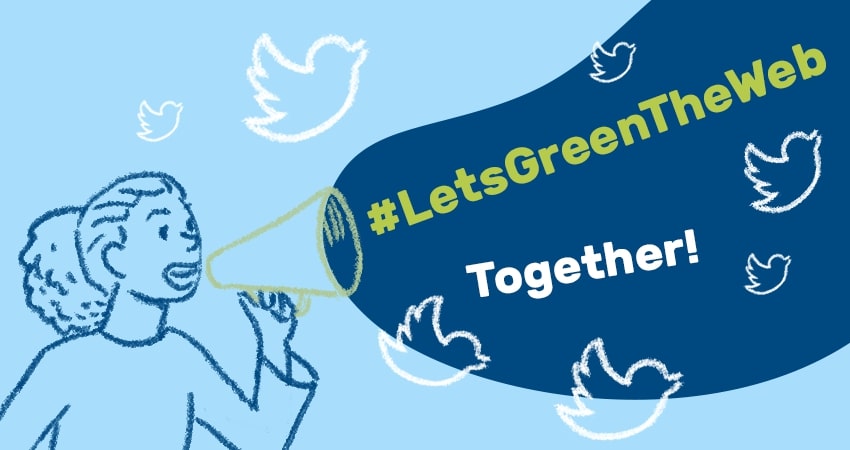Did you know that every time a website is loaded, it’s responsible for carbon emissions?
You bet it is!
In fact, it’s estimated that if the Internet were a country, it would be the world’s seventh-biggest polluter (Sustainable Web Manifesto, 2021). If we continue business-as-usual, the IT sector will be responsible for 14% of the world’s carbon emissions by 2040 [HBR, 2020] – the time is now to take action and do something about this.
Some of us volunteers at ClimateAction.tech got together to talk about this problem, brainstorming and bouncing around ideas. We wanted to do more than talk about it though, we wanted to take action, and so the #LetsGreenTheWeb campaign was born.
What is the #LetsGreenTheWeb campaign?
The #LetsGreenTheWeb campaign is a focused, 5-day Twitter campaign to encourage and support everybody to measure the carbon emissions of websites and share tweets highlighting the results. The campaign will run on Twitter over the course of a week, planned for February 15–19, 2021.
#LetsGreenTheWeb aims to raise awareness of these issues and both encourage, as well as support, those who run websites to take action and reduce their carbon emissions. For more information about our aims, objectives and approach read our #LetsGreenTheWeb project brief.
An important note is that we have a desire for encouraging positive behaviour change and building community. We are all in this together and collectively want to see a future with more carbon-friendly websites. Reaching out to others to talk about this problem in a constructive way is key if we want others to respond and take action.
How do I get involved with #LetsGreenTheWeb?
Join us on a mission to make public websites more sustainable! By working together we can reduce carbon emissions resulting from viewing a publicly available site.
Our ClimateAction.tech Twitter account
Our Twitter campaign hashtag: #LetsGreenTheWeb
Amplify the campaign
We want to get as many people taking action to green the Web, so here are some ideas, graphics, and templates to help you spread the message:
- Share the campaign on your personal social media accounts.
- Share the campaign with communities you’re a part of.
- Collaborate with your company’s social media coordinator to have them share it.
You’ll find everything you’d need in the #LetsGreenTheWeb Media Package such as graphics for Twitter, Facebook, Instagram and LinkedIn, and templates you can use to communicate with others.
Use your influence at your company to reduce the emissions of your website
As an employee, you have power! Organisations are vast and widespread, but they are all made up of individual people. Here are 4 simple steps to follow:
- Figure out which of your colleagues is involved with designing, building, and/or creating content for the website.
- Run the website on the Website Carbon Calculator to measure the carbon emissions.
- Reach out to these colleagues for a virtual coffee/tea chat about the topic.
- Have a friendly and positive conversation to learn more about their views on climate change, then share the results that you found with them as an exciting opportunity to take action.
See our Action Guide: Reduce the Carbon Emissions of Your Website for more details on how to get started with reducing the carbon emissions, templates you can use and to see how others are taking action.
Participate in the campaign
Between the 15th and 19th Feb, when our Twitter campaign is running, use the Website Carbon Calculator to measure the carbon emissions of websites. Post the results of these checks on Twitter using positive language (whether the results are good or not). By doing this you will help to raise awareness of the issue in general, as well reaching out to the owner of a specific website.
Even if you’re not on Twitter, you can still use your voice in other ways to spread the message.
See our Action Guide: Share the Carbon Impact of a Website for more details on how to do this, templates you can use and to see how others are taking action.
How do websites create carbon emissions?
Reducing the carbon emissions associated with a website boils down to reducing the amount of electricity being used to load, send, and view a web page, as well as ensuring the resulting electricity needed is from clean, renewable resources.
If you want to learn more about this topic head over to our Action Guide: Reduce the Carbon Emissions of Your Website.
Join the discussion!
If have questions, ideas or resources to share please use the comments section at the end of this post. If you are already a CAT member you can reach out to us directly in our #d-action Slack channel.
